
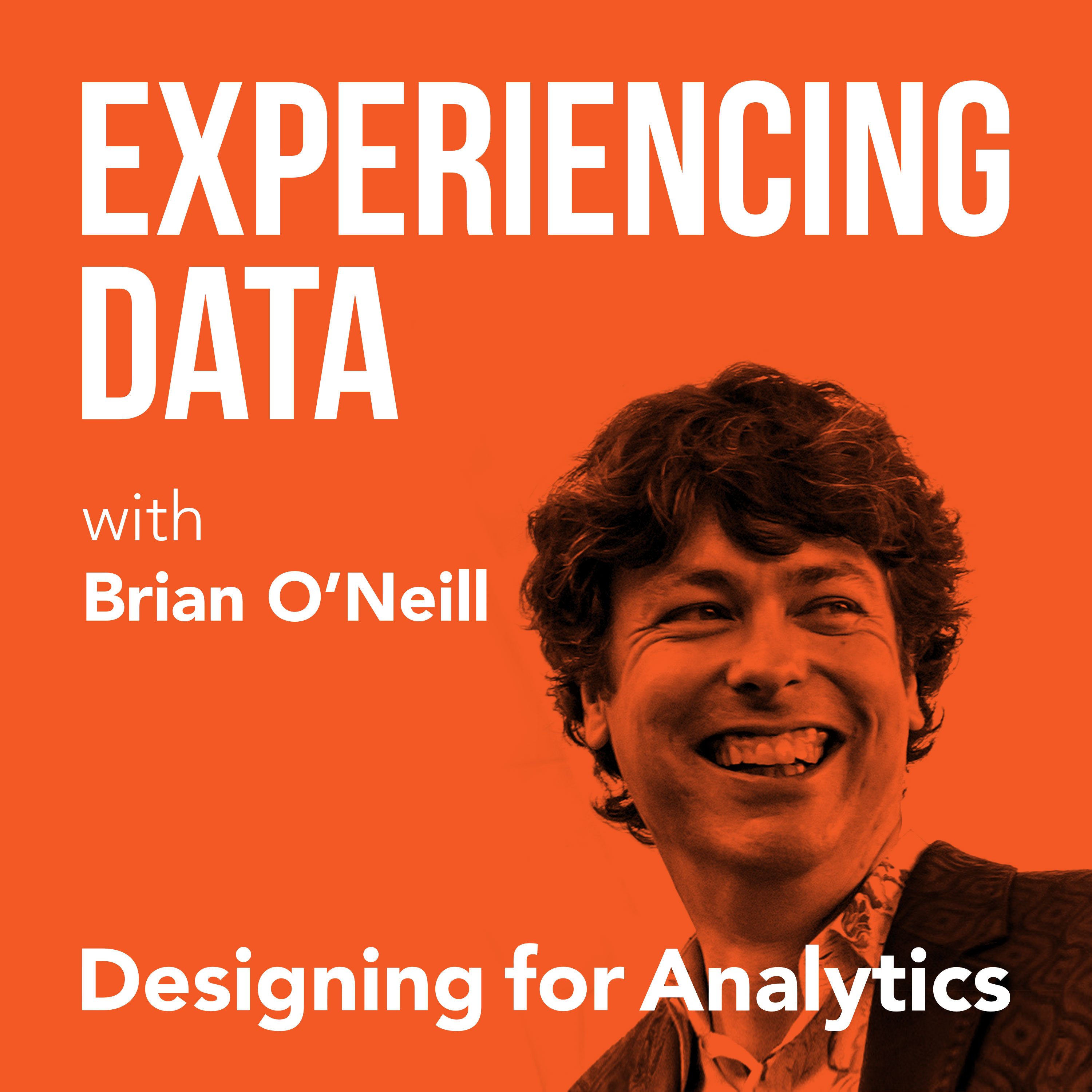
142.4K
Downloads
174
Episodes
Is the value of your enterprise analytics SAAS or AI product not obvious through it’s UI/UX? Got the data and ML models right...but user adoption of your dashboards and UI isn’t what you hoped it would be? While it is easier than ever to create AI and analytics solutions from a technology perspective, do you find as a founder or product leader that getting users to use and buyers to buy seems harder than it should be? If you lead an internal enterprise data team, have you heard that a ”data product” approach can help—but you’re concerned it’s all hype? My name is Brian T. O’Neill, and on Experiencing Data—one of the top 2% of podcasts in the world—I share the stories of leaders who are leveraging product and UX design to make SAAS analytics, AI applications, and internal data products indispensable to their customers. After all, you can’t create business value with data if the humans in the loop can’t or won’t use your solutions. Every 2 weeks, I release interviews with experts and impressive people I’ve met who are doing interesting work at the intersection of enterprise software product management, UX design, AI and analytics—work that you need to hear about and from whom I hope you can borrow strategies. I also occasionally record solo episodes on applying UI/UX design strategies to data products—so you and your team can unlock financial value by making your users’ and customers’ lives better. Hashtag: #ExperiencingData. JOIN MY INSIGHTS LIST FOR 1-PAGE EPISODE SUMMARIES, TRANSCRIPTS, AND FREE UX STRATEGY TIPS https://designingforanalytics.com/ed ABOUT THE HOST, BRIAN T. O’NEILL: https://designingforanalytics.com/bio/
Episodes
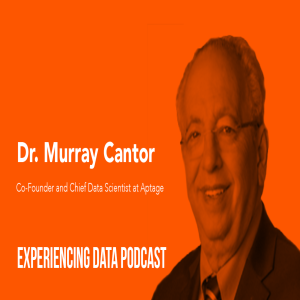
Tuesday Oct 08, 2019
Tuesday Oct 08, 2019
 Dr. Murray Cantor has a storied career that spans decades. Recently, he founded Aptage, a company that provides project risk management tools using Bayesian Estimation and machine learning. He’s also the chief scientist at Hail Sports, which focuses on applying precision medicine techniques to sports performance. In his spare time, he’s a consulting mathematician at Pattern Computer, a firm that engineers state-of-the-art pattern recognition solutions for industrial customers.
Dr. Murray Cantor has a storied career that spans decades. Recently, he founded Aptage, a company that provides project risk management tools using Bayesian Estimation and machine learning. He’s also the chief scientist at Hail Sports, which focuses on applying precision medicine techniques to sports performance. In his spare time, he’s a consulting mathematician at Pattern Computer, a firm that engineers state-of-the-art pattern recognition solutions for industrial customers.
Join Murray and I as we explore the cutting edge of AI and cover:
- Murray’s approach to automating processes that humans typically do, the role humans have in the design phase, and how he thinks about designing affordances for human intervention in automated systems
- Murray’s opinion on causal modeling (explainability/interpretability), the true stage we are in with XAI, and what’s next for causality in AI models
- Murray’s opinions about the 737 Max’s automated trim control system interface (or lack thereof) and how it should have been designed The favorite method Murray has for predicting outcomes from small data sets
- The major skill gaps Murray sees with young data scientists in particular
- How using science fiction stories can stimulate creative thinking and help kick off an AI initiative successfully with clients, customers and stakeholders
Resources and Links
New York Times Expose article on the Boeing 737 Max
New Your Times Article on the 737 Max whistleblower
Quotes from Today’s Episode
“We’re in that stage of this industrial revolution we’re going through with augmenting people’s ability with machine learning. Right now it’s more of a craft than a science. We have people out there who are really good at working with these techniques and algorithms. But they don’t necessarily understand they’re essentially a solution looking for a problem.” — Murray
“A lot of design principles are the same whether or not you have AI. AI just raises the stakes.” — Murray
“The big companies right now are jumping the guns and saying they have explainable AI when they don’t. It’s going to take a while to really get there.” — Murray
“Sometimes, it’s not always understood by non-designers, but you’re not testing the people. You’re actually testing the system. In fact, sometimes they tell you to avoid using the word test when you’re talking to a participant, and you tell them it’s a study to evaluate a piece of software, or in this case a cockpit, to figure out if it’s the right design or not. It’s so that they don’t feel like they’re a rat in the maze. In reality, we’re studying the maze.” — Brian
“Really fundamental to understanding user experience and design is to ask the question, who is the population of people who are going to use this and what is their range of capability?” – Murray
“Take the implementation hats off and come up with a moonshot vision. From the moonshot, you might find out there are these little tangents that are actually feasible increments. If you never let yourself dream big, you’ll never hit the small incremental steps that you may be able to take.” — Brian
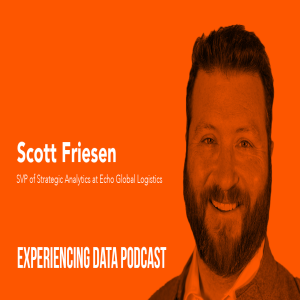
Tuesday Sep 24, 2019
Tuesday Sep 24, 2019
 Scott Friesen’s transformation into a data analytics professional wasn’t exactly linear. After graduating with a biology degree and becoming a pre-med student, he switched gears and managed artists in the music industry. After that, he worked at Best Buy, eventually becoming their Senior Director of Analytics for the company’s consumer insights unit. Today, Scott is the SVP of Strategic Analytics at Echo Global Logistics, a provider of technology-enabled transportation and supply chain management services. He also advises for the International Institute for Analytics.
Scott Friesen’s transformation into a data analytics professional wasn’t exactly linear. After graduating with a biology degree and becoming a pre-med student, he switched gears and managed artists in the music industry. After that, he worked at Best Buy, eventually becoming their Senior Director of Analytics for the company’s consumer insights unit. Today, Scott is the SVP of Strategic Analytics at Echo Global Logistics, a provider of technology-enabled transportation and supply chain management services. He also advises for the International Institute for Analytics.
In this episode, Scott shares what he thinks data scientists and analytics leaders need to do to become a trustworthy and indispensable part of an organization. Scott and I both believe that designing good decision support applications and creating useful data science solutions involve a lot more than technical knowledge. We cover:
- Scott’s trust equation, why it’s critical for analytics professionals, and how he uses it to push transformation across the organization
- Scott’s “jazz” vs “classical” approach to creating solutions
- How to develop intimacy and trust with your business partners (e.g., IT) and executives, and the non-technical skills analytics teams need to develop to be successful
- Scott’s opinion about design thinking and analytics solutions
- How to talk about risk to business stakeholders when deploying data science solutions
- How the success of Scott’s new pricing model was impeded by something that had nothing to do with the data—and how he addressed it
- Scott’s take on the emerging “analytics translator” role
- The two key steps to career success—and volcanos
Resources and Links
Quotes from Today's Episode
“You might think it is more like classical music, but truly great analytics are more like jazz. ” — Scott
“If I'm going to introduce change to an organization, then I'm going to introduce perceived risk. And so the way for me to drive positive change—the way for me to drive adding value to the organizations that I'm a part of—is the ability to create enough credibility and intimacy that I can get away with introducing change that benefits the organization.” — Scott
“I categorize the analytic pursuit into three fundamental activities: The first is to observe, the second is to relate, and the third is to predict. ” — Scott
“It's not enough to just understand the technology part and how to create great models. You can get all that stuff right and still fail in the last mile to deliver value.” — Brian
“I tend to think of this is terms of what you called ‘intimacy.’ I don’t know if you equate that to empathy, which is really understanding the thing you are talking about from the perspective of the other person. When we do UX research, the questions themselves are what form this intimacy. An easy way to do that is by asking open-ended questions that require open-ended answers to get that person to open up to you. ” — Brian
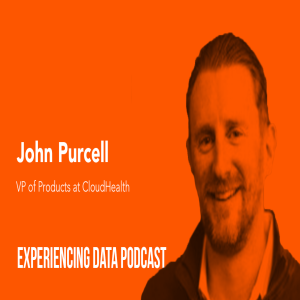
Tuesday Sep 10, 2019
Tuesday Sep 10, 2019
 John Purcell has more than 20 years of experience in the technology world. Currently, he’s VP of Products at CloudHealth, a company that helps organizations manage their increasingly complex cloud infrastructure effectively. Prior to this role, he held the same position at SmartBear Software, makers of application performance monitoring solutions. He’s also worn several hats at companies like LogMeIn and Red Bend Software.
John Purcell has more than 20 years of experience in the technology world. Currently, he’s VP of Products at CloudHealth, a company that helps organizations manage their increasingly complex cloud infrastructure effectively. Prior to this role, he held the same position at SmartBear Software, makers of application performance monitoring solutions. He’s also worn several hats at companies like LogMeIn and Red Bend Software.
In today’s episode, John and I discuss how companies are moving more and more workloads to the cloud and how John and his team at CloudHealth builds a platform that makes it easy for all users—even non-technical ones—to analyze and manage data in the cloud and control their financial spending. In addition to exploring the overall complexity of using analytics to inform the management of cloud environments, we also covered:
- How CloudHealth designs for multiple personas from the financial analyst to the DevOps operator when building solutions into the product
- Why John has “maniacal point of view” and “religion” around design and UX and how they have the power to disrupt a market
- How design helps turn otherwise complex data sets that might require an advanced degree to understand into useful decision support
- How data can lead to action, and how CloudHealth balances automation vs. manual action for its customers using data to make decisions
- Why John believes user experience is a critical voice at the table during the very earliest stages of any new analytics/data initiative
Resources and Links
Twitter: @PurcellOutdoors
Quotes from Today’s Episode
“I think that’s probably where the biggest point of complexity and the biggest point of challenge is for us: trying to make sure that the platform is flexible enough to be able to inject datasets we’ve never seen before and to be able to analyze and find correlations between unknown datasets that we may not have a high degree of familiarity with—so that we can generate insight that’s actionable, but deliver it in a way that’s [easy for anyone to understand].” — John
“My core philosophy is that you need UX at the table early and at every step along the way as you’re contemplating product delivery, and I mean all the way upstream at the strategic phase, at the identification of what you want to go tackle next including product strategy, pain identification, persona awareness, and who are we building for—all the way through solving the problem, what should the product be capable of, and user validation.” — John
“in the cloud, we’re just at the very early stages of [automation based on analytics] from a pure DevOps point of view. We’re still in the world of show me your math. Show me why this is the recommendation you’re making.” — John
“When making decisions using data, some IT people don’t like the system taking action without them being involved because they don’t trust that any product would be smart enough to make all the right decisions, and they don’t want applications going down.” — Brian
“I think the distinction you made between what I would call user interface design, which is the surface layer, buttons, fonts, colors, all that stuff often gets conflated in the world of analytics as being, quote ‘design.’ And as I think our audience is hearing from John here, is that it [design] goes much beyond that. It can get into something like, ‘how do you design a great experience around API documentation? Where’s the demo code? How do I run the demo?’ All of that can definitely be designed as well.” — Brian
“I hear frequently in my conversations with clients and people in the industry that there are a lot of data scientists who just want to use the latest models, and they want to work on model quality and predictive accurateness, etc. But they’re not thinking about how someone is going to use this model to make a decision, and whether will there be some business value created at the end.” — Brian
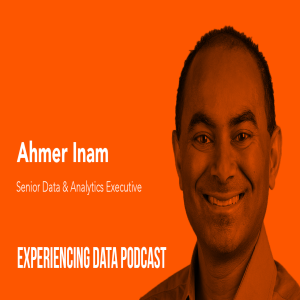
Tuesday Aug 27, 2019
Tuesday Aug 27, 2019
 Ahmer Inam considers himself an evangelist of data science who’s been “doing data science since before it was called data science. With more than 20 years of leadership experience in the data science and analytics field at companies including Nike and Cambia health, Ahmer knows a thing or two about what makes data science projects succeed—and what makes them fail.
Ahmer Inam considers himself an evangelist of data science who’s been “doing data science since before it was called data science. With more than 20 years of leadership experience in the data science and analytics field at companies including Nike and Cambia health, Ahmer knows a thing or two about what makes data science projects succeed—and what makes them fail.
In today’s episode, Ahmer and I discuss his experiences using design thinking and his “human-centered AI” process to ensure that internal analytics and data science initiatives actually produce usable, useful outputs that turn into business value. Much of this was formed while Ahmer was a Senior Director and Head of Advanced Analytics at Nike, a company that is known as a design-mature organization. We covered:
- The role of empathy in data science teams and how it helps data people connect with non-technical users who may not welcome “yet another IT tool”
- Ahmer’s thoughts on Lean Coaching, Scrum Teams, and getting outside help to accelerate the design and creation of your first data products and predictive models
- The role of change management in the process of moving data products into production
- Ahmer’s two-week process to kick-start data product initiatives used at Nike
- How model accuracy isn’t as important early on as other success metrics when prototyping solutions with customers
Resources and Links
How Analytics Are Informing Change At Nike
Quotes from Today’s Episode
“Build data products with the people, for the people…and bring a sense of vulnerability to the table.” — Ahmer
“What I have seen is that a lot of times we can build models, we can bring the best of the technologies on optimal technology it’s in the platforms, but in the end, if the business process and the people are not ready to take it and use it, that’s where it fails.” — Ahmer
“If we don’t understand people in the process, essentially, the adoption is not going to work. In the end, when it comes to a lot of these data science exercises or projects or development of data products, we have to really think about it as a change management exercise and nothing short of that.” — Ahmer
“Putting humans at the center of these initiatives drives better value and it actually makes sure that these tools and data products that we’re making actually get used, which is what ultimately is going to determine whether or not there’s any business value—because the data itself doesn’t have any value until it’s acted upon.” — Brian
“One of these that’s been stuck in my ear like an earworm is that a lot of the models fail to get to production still. And so this is the ongoing theme of basically large analytics projects, whether you call it big data analytics or AI, it’s the same thing. We’re throwing a lot of money at these problems, and we’re still creating poor solutions that end up not doing anything.” — Brian
“I think the really important point here is that early on with these initiatives, it’s important to figure out, What is going to stop this person from potentially engaging with my service?” — Brian
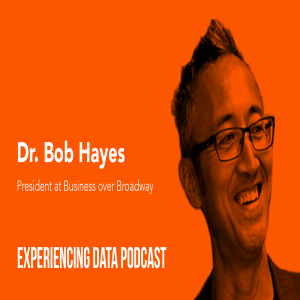
Tuesday Aug 13, 2019
Tuesday Aug 13, 2019
 Dr. Bob Hayes, will be the first to tell you that he’s a dataphile. Ever since he took a stats course in college in the 80s, Bob’s been hooked on data. Currently, Bob is the Research and Analytics Director at Indigo Slate. He’s also the president of Business over Broadway, a consultancy he founded in 2007.In a past life, Bob served as Chief Research Officer at Appuri and AnalyticsWeek, Chief Customer Officer at TCELab, and a contributing analyst at Gleanster, among many other roles.
Dr. Bob Hayes, will be the first to tell you that he’s a dataphile. Ever since he took a stats course in college in the 80s, Bob’s been hooked on data. Currently, Bob is the Research and Analytics Director at Indigo Slate. He’s also the president of Business over Broadway, a consultancy he founded in 2007.In a past life, Bob served as Chief Research Officer at Appuri and AnalyticsWeek, Chief Customer Officer at TCELab, and a contributing analyst at Gleanster, among many other roles.
In today’s episode, Bob and I discuss a recent Kaggle survey that highlighted several key non-technical impediments to effective data science projects. In addition to outlining what those challenges are and exploring potential solutions to them, we also covered:
- The three key skills successful data science teams have
- Why improving customer loyalty involves analyzing several metrics, not just one
- Why Bob feels the scientific method is just as important today as it’s been for hundreds of years
- The importance of repeatable results
- How prototyping early can save time and drive adoption of data science projects
- Bob’s advice on how to move data science projects forward (and one key skill he feels most business leaders lack)
- The role of the analytics translator
Resources and Links:
Quotes from Today’s Episode
“I’ve always loved data. I took my first stats course in college over 30 years ago and I was hooked immediately. I love data. Sometimes I introduce myself as a dataholic. I love it.” — Bob
“I’m a big fan of just kind of analyzing data, just getting my hands on data, just exploring it. But that can lead you down a path of no return where you’re just analyzing data just to analyze it. What I try to tell my clients is that when you approach a data set, have a problem that you’re trying to solve. The challenge there I think it stems from the fact that a lot of data science teams don’t have a subject matter expert on the team to pose the right questions.” — Bob
“The three findings that I found pretty interesting were, number one, a lack of a clear question to be answering or a clear direction to go in with the available data. The second one was that data science results were not used by the business decision makers. And the third one was an inability to integrate findings into the organization’s decision making processes.” — Brian
“It makes you wonder,‘if you didn’t have a good problem to solve, maybe that’s why [the findings] didn’t get used in the first place.’” — Brian
“That part isn’t so much the math and the science. That’s more the psychology and knowing how people react. Because you’re going to have certain business stakeholders that still want to kind of shoot from the hip and their experience. Their gut tells them something. And sometimes that gut is really informed.” — Brian
“If executives are looking at data science and AI as a strategic initiative, it seems really funny to me that someone wouldn’t be saying, ‘What do we get out of this? What are the next steps?’ when the data teams get to the end of a project and just moves on to the next one.” — Brian
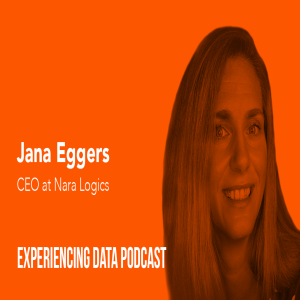
Tuesday Jul 30, 2019
Tuesday Jul 30, 2019

Jana Eggers, a self-proclaimed math and computer nerd, is CEO of Nara Logics, a company that helps organizations use AI to eliminate data silos and unlock the full value of their data, delivering predictive personalized experiences to their customers along the way. The company leverages the latest neuroscience research to model data the same way our brains do. Jana also serves on Fannie Mae’s digital advisory board, which is tasked with finding affordable housing solutions across the United States. Prior to joining Nara Logics, Jana wore many different hats, serving as CEO of Spreadshirt, and General Manager of QuickBase at Intuit, among other positions. She also knows about good restaurants in PDX!
In today’s episode, Jana and I explore her approaches to using AI to help enterprises make interesting and useful predictions that drive better business outcomes and improve customer experience. In addition to discussing how AI can help strengthen personalization and support smarter decision making, we also covered:
- The power of showing the whys when providing predictions (i.e., explainable AI or XAI).
- Jana’s thoughts on why some data scientists struggle with inflated expectations around AI
- Brian’s #facepalm about lipstick and data
- The power of what-if simulations and being able to remove factors from predictions
- The power of context and how Nara Logics weighs recent data vs. long-term historical data in its predictions
- How Nara Logics leverages the wiring of the brain—the connectome—to inspire the models they build and the decision support help they provide to customers
- Why AI initiatives need to consider the “AI trinity”: data, the algorithm, and the results an organization is aiming for
Resources and Links:
Quotes from Today’s Episode
“We have a platform that is really built for decision support. How do you go from having […]20 to having about 500 to 2,000 decision factors coming in? Once we get that overload of information, our tool is used to help people with those decisions. And yes, we’re using a different approach than the traditional neural net, which is what deep learning is based on. While we use that in our tool, we’re more on the cognitive side. […]I’ve got a lot of different signals coming in, how do I understand how those signals relate to each other and then make decisions based on that?” — Jana
“One of the things that we do that also stands us apart is that our AI is transparent—meaning that when we provide an answer, we also give the reasons why that is the right answer for this context. We think it is important to know what was taken into account and what factors weigh more heavily in this context than other contexts.” — Jana
“It is extremely unusual—and I can even say that I’ve never really seen it—that people just say, Okay, I trust the machine. I’m comfortable with that. It knows more than me. That’s really unusual. The only time I’ve seen that is when you’re really doing something new and no one there has any idea what it should be.” — Jana
“With regards to tech answering “why,” I’ve worked on several monitoring and analytics applications in the IT space. When doing root cause analysis, we came up with this idea of referring to monitored objects as being abnormally critical and normally critical. Because at certain times of day, you might be running a backup job and so the IO is going crazy, and maybe the latency is higher. But the IO is supposed to be that way at that time. So how do you knock down that signal and not throw up all the red flags and light up the dashboard when it’s supposed to be operating that way? Answering “why” is difficult. ” — Brian
“We’ve got lipstick, we’ve got kissing. I’m going to get flagged as ‘parental advisory’ on this episode in iTunes probably. ;-)” — Brian
“You can’t just live in the closet and do your math and hope that everyone is going to see the value of it. Anytime we’re building these complex tools and services —what I call human-in-the-loop applications–you’re probably going to have to go engage with other humans, whether it’s customers or your teammates or whatever.” — Brian
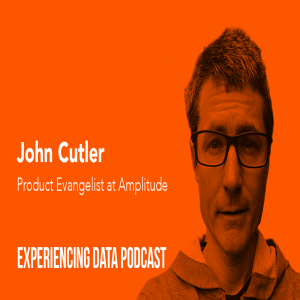
Tuesday Jul 16, 2019
Tuesday Jul 16, 2019
 John Cutler is a Product Evangelist for Amplitude, an analytic platform that helps companies better understand users behavior, helping to grow their businesses. John focuses on user experience and evidence-driven product development by mixing and matching various methodologies to help teams deliver lasting outcomes for their customers. As a former UX researcher at AppFolio, a product manager at Zendesk, Pendo.io, AdKeeper and RichFX, a startup founder, and a product team coach, John has a perspective that spans individual roles, domains, and products.
John Cutler is a Product Evangelist for Amplitude, an analytic platform that helps companies better understand users behavior, helping to grow their businesses. John focuses on user experience and evidence-driven product development by mixing and matching various methodologies to help teams deliver lasting outcomes for their customers. As a former UX researcher at AppFolio, a product manager at Zendesk, Pendo.io, AdKeeper and RichFX, a startup founder, and a product team coach, John has a perspective that spans individual roles, domains, and products.
In today’s episode, John and I discuss how productizing storytelling in analytics applications can be a powerful tool for moving analytics beyond vanity metrics. We also covered the importance of understanding customers’ jobs/tasks, involving cross-disciplinary teams when creating a product/service, and:
- John and Amplitude’s North Star strategy and the (3) measurements they care about when tracking their own customers’ success
- Why John loves the concept of analytics “notebooks” (also a particular feature of Amplitude’s product) vs. the standard dashboard method
- Understanding relationships between metrics through “weekly learning users” who share digestible content
- John’s opinions on involving domain experts and cross-discipline teams to enable products focused on outcomes over features
- Recognizing whether your product/app is about explanatory or exploratory analytics
- How Jazz relates to business – how you don’t know what you don’t know yet
Resources and Links:
Quotes from Today’s Episode
“It’s like you know in your heart you should pair with domain experts and people who know the human problem out there and understand the decisions being made. I think organizationally, there’s a lot of organizational inertia that discourages that, unfortunately, and so you need to fight for it. My advice is to fight for it because you know that that’s important and you know that this is not just a pure data science problem or a pure analytics problem. There’s probably there’s a lot of surrounding information that you need to understand to be able to actually help the business.” – John
“We definitely ‘dogfood’ our product and we also ‘dogfood’ the advice we give our customers.” – John
“You know in your heart you should pair with domain experts and people who know the human problem out there and understand the decisions being made. […] there’s a lot of organizational inertia that discourages that, unfortunately, and so you need to fight for it. I guess my advice is, fight for it, because you know that it is important, and you know that this is not just a pure data science problem or a pure analytics problem.” – John
“It’s very easy to create assets and create code and things that look like progress. They mask themselves as progress and improvement, and they may not actually return any business value or customer value explicitly. We have to consciously know what the outcomes are that we want.” – Brian
“We got to get the right bodies in the room that know the right questions to ask. I can smell when the right questions aren’t being asked, and it’s so powerful” – Brian
“Instead of thinking about what are all the right stats to consider, [I sometimes suggest teams] write in plain English, like in prose format, what would be the value that we could possibly show in the data.’ maybe it can’t even technically be achieved today. But expressing the analytics in words like, ‘you should change this knob to seven instead of nine because we found out X, Y, and Z happened. We also think blah, blah, blah, blah, blah, and here is how we know that, and there’s your recommendation.’ This method is highly prescriptive, but it’s an exercise in thinking about the customer’s experience.” – Brian
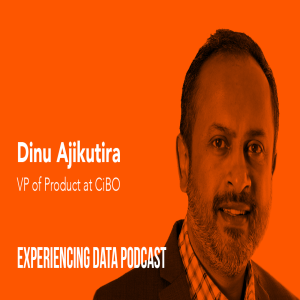
Tuesday Jul 02, 2019
Tuesday Jul 02, 2019
 Today we are joined by Dinu Ajikutira, VP of Product at CiBO Technologies. CiBO Technologies was founded in 2015. It was created to provide an objective, scientifically-driven insights in support of farmland economics. Dinu is currently leading an effort to productize what I found to be some very impressive analytically-driven simulation capabilities to help farmers and agronomists. Specifically, CiBO’s goal is to provide a software service that uses mapping and other data to predictively model a piece of land’s agricultural value –before crops are ever planted. In order to build a product that truly meets his customer needs, Dinu goes the extra mile–in one case, 1000 miles– to literally meet his customers in the field to understand their pain points.
Today we are joined by Dinu Ajikutira, VP of Product at CiBO Technologies. CiBO Technologies was founded in 2015. It was created to provide an objective, scientifically-driven insights in support of farmland economics. Dinu is currently leading an effort to productize what I found to be some very impressive analytically-driven simulation capabilities to help farmers and agronomists. Specifically, CiBO’s goal is to provide a software service that uses mapping and other data to predictively model a piece of land’s agricultural value –before crops are ever planted. In order to build a product that truly meets his customer needs, Dinu goes the extra mile–in one case, 1000 miles– to literally meet his customers in the field to understand their pain points.
On this episode, Dinu and I discuss how CiBO will help reduce farmers’ risk, optimize crop yields, and the challenges of the agriculture industry from a data standpoint. We also discussed:
- Farmers’ interactions with data analytics products and how to improve their trust with those products
- Where CiBO’s software can be used and who would benefit from it
- Dinu’s “ride-along” experience visiting farmers and agronomists in the midwest to better understand customer needs and interactions with the tool
- What Dinu has learned about farmers’ comfort using technology
- The importance of understanding seasonality
- The challenges of designing the tool for the various users and building user interfaces based on user needs
- The biggest product challenges in the ag tech field and how CiBO handles those challenges
Resources and Links:
Quotes from Today’s Episode
“CiBO was built on a mission of enabling sustainable agriculture, and we built this software platform that brings weather, soil, topography, and agronomic practices in combination with simulation to actually digitally grow the plant, and that allows us to explain to the users why something occurs, what if something different had happened, and predict the outcomes of how plants will perform in different environments.” — Dinu Ajikutira
“The maturity of the agricultural industry [with regards] to technology is in its early stages, and it’s at a time when there is a lot of noise around AI,machine learning and data analytics. That makes it very complicated, because you don’t know if the technology really does what it claims to do, and there is a community of potential users that are not used to using a high-tech technology to solve their problems.” — DInu Ajikutira
“In agriculture, the data is very sparse, but with our software we don’t need all the data. We can supplement data that is missing, using our simulation tools, and be able to predict weather outcomes that you have not experienced in the past.” — Dinu Ajikutira
“To add clarity, you need to add information sometimes, and the issue isn’t always the quantity of the information; it’s how it’s designed.I’ve seen this repeatedly where there are times if you properly add information and design it well, you actually bring a lot more insight.” – Brian O’Neill
“Sometimes the solution is going to be to add information, and if you’re feeling like you have a clutter problem, if your customers are complaining about too much information, or that’s a symptom usually that the design is wrong. It’s not necessarily that that data has no value. It may be the wrong data.” — Brian O’Neill
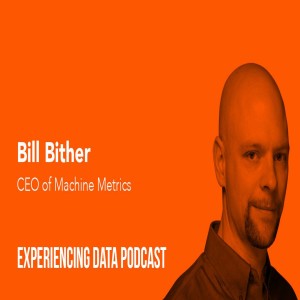
Tuesday Jun 18, 2019
Tuesday Jun 18, 2019
 Bill Bither, CEO and Co-Founder of MachineMetrics, is a serial software entrepreneur and a manufacturing technology leader. He founded and bootstrapped Atalasoft to image-enable web applications which led to a successful exit in 2011 to Kofax. In 2014, he co-founded MachineMetrics to bring visibility and predictability to the manufacturing floor with an Industrial IoT analytics platform that collects data from machines. This data is used to benchmark performance, drive efficiency, improve equipment uptime, and enable automation.
Bill Bither, CEO and Co-Founder of MachineMetrics, is a serial software entrepreneur and a manufacturing technology leader. He founded and bootstrapped Atalasoft to image-enable web applications which led to a successful exit in 2011 to Kofax. In 2014, he co-founded MachineMetrics to bring visibility and predictability to the manufacturing floor with an Industrial IoT analytics platform that collects data from machines. This data is used to benchmark performance, drive efficiency, improve equipment uptime, and enable automation.
Today, join us as we discuss the various opportunities and challenges in the complex world of industrial IoT and manufacturing. Bill and I discuss the importance of visualizations and its relationship to improving efficiency in manufacturing, how talking to machine operators help add context to analytics data and even inform UI/UX decisions, as well as how MachineMetrics goes about making the telemetry from these machines useful to the operators.
We also covered:
- How improving a customer’s visibility into CNC machines helped reveal accurate utilization rates and improved efficiency
- How simple visualizations make a tangible difference in operational performance
- Bill’s model for the 4 different phases of analytics
- Descriptive
- Diagnostic
- Predictive
- Prescriptive
- Mistakes Bill learned early on about product dev in the IIoT analytics space
- What Bill learned from talking to customers that ended up identifying a major design flaw his team wasn’t aware of
- The value you can glean from talking to customers
- MachineWorks’ challenges with finding their market fit and aligning their product around customer’s needs
- How MachineMetrics has learned to simplify the customer’s analytics experience
Resources and Links
Quotes from Today’s Episode
“We have so much data, but the piece that really adds enormous value is human feedback.” — Bill
“Simplicity is really hard. It takes time because it requires empathy and it requires going in and really getting into the head or the life of the person that’s gonna use your tool. You have to understand what’s it like being on a shop floor running eight different CNC machines. If you’ve never talked to someone, it’s really hard to empathize with them.” — Brian
“In all the work that we do, in adding more intelligence to the product, it’s just making the experience simpler and simpler.” — Bill
“You don’t have to go in and do great research; you can go in and just start doing research and learn on the way. It’s like going to the gym. They always tell you, ‘It doesn’t matter what exercise you do, just go and start.’ …then you can always get better at making your workout optimal.” — Brian
“It’s really valuable to have routine visits with customers, because you just don’t know what else might be going on.” — Brian
“The real value of the research is asking ‘why’ and ‘how,’ and getting to the root problem. That’s the insight you want. Customers may have some good design ideas, but most customers aren’t designers. … Our job is to give people what they need.” — Brian
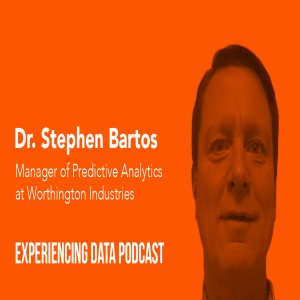
Tuesday Jun 04, 2019
Tuesday Jun 04, 2019

Today we are joined by the analytics “man of steel,” Steve Bartos, the Manager of the Predictive Analytics team in the steel processing division at Worthington Industries. 😉 At Worthington, Steve is tasked with strategically driving impactful analytics wider and deeper across the division and, as part of this effort, helps ensure an educated, supported, and connected analytics community. In addition, Steve also serves as a co-leader of the Columbus Tableau User Group.
On today’s episode, Steve and I discuss how analytics are providing internal process improvements at Worthington. We also cover the challenges Steve faces designing effective data-rich products, the importance of the “last mile,” and how his PhD in science education shapes his work in predictive analytics.
In addition, we also talk about:
- Internal tools that Steve has developed and how they help Worthington Industries.
- Preplanning and its importance for creating a solution that works for the client.
- Using analytics to inform daily decisions, aid in monthly meetings, and assist with Kaizen (Lean) focused decisions.
- How Steve pulls out the meaningful pieces of information that can improve the division’s performance.
- How Steve tries to avoid Data-Rich and Insight-Poor customer solutions
- The importance of engaging the customer/user throughout the process
- How Steve leverages his science education background to communicate with his peers and with executives at Worthington
Resources and Links
Quotes from Today’s Episode
“Seeing the way analytics can help facilitate better decision making, doesn't necessarily come with showing someone every single question they can possibly answer, waiting for them to applaud how much time and how much energy and effort you'd saved them.” - Steve Bartos
“It's hard to talk about the influence of different machine parameters on quality if every operator is setting it up based on their own tribal knowledge of how it runs best.” - Steve Bartos
“I think bringing the question back to the user much more frequently, much sooner and at a much more focused scale has paid dividends”. - Steve Bartos
“It's getting the people that are actually going to sit and use these interfaces involved in the creation process… they should be helping you define the goals and the problems… by getting them involved, it makes the adoption process a lot easier.” - Brian O’Neill
“It's real easy to throw up some work that you've done in Tableau around a question that a manager or an executive had. It's real easy to do that. It's really difficult to do that well and have some control of the conversation, being able to say, here's what we did, here was the question, here's the day we use, here's how we analyze it and here's a suggestion where making and now let's talk about why and do that in a way that doesn't lead to an in-the-weeds session and frustration.” - Steve Bartos